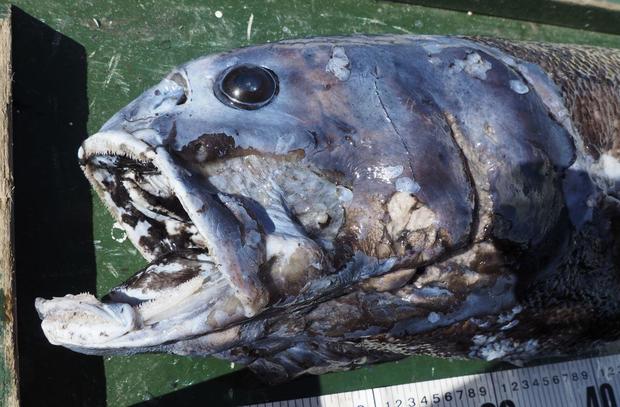A sunny winter day in 2016 found marine biologist Yoshihiro Fujiwara anchored off the coast of central Japan, measuring pudgy cusk eels, when a hubbub suddenly erupted aboard ship. The crew of the Shonan Maru had just landed a big, bizarre-looking fish.
“Wow! We got a coelacanth!” they joked as they hauled up a specimen so large it evoked the legendary “living fossil” species found only in Africa and Indonesia.
Fujiwara, whose specialty is “whale fall” communities — the rich ecosystems that spring up around and feed off whale carcasses — was equal parts thrilled and skeptical.
“It was exciting,” he told CBS News. “But this is a very well-studied bay.”
Indeed it is. Researchers have been building a taxonomy of specimens from Suruga, Japan’s deepest bay, since the 19th century.
The area is also one of the most heavily fished in the world. Surely, Fujiwara thought, someone had spotted this colossal creature before.
Amazingly, no one had. Fujiwara and his team from the Japan Agency for Marine-Earth Science and Technology (JAMSTEC) cross-checked reference books and consulted with colleagues around the world before concluding the spear-shaped, purple-hued creature from the deep was indeed a bonafide discovery.
Three more specimens of the monster fish would be hooked that year, quickly preserved in formaldehyde or frozen for later perusal in the lab.
Dissection, CT-scans and other analysis situated the specimen within the alepocephalid family, a deep-sea species distributed worldwide and popularly known as “slickheads,” for their scale-free heads and gill covers. But unlike its much smaller relatives, which average just 14 inches in length, this was a beast: At 55 inches long and 55 pounds, it had the size and heft of a small child.
Fujiwara and his team decided to name the new species “yokozuna slickhead,” after the top rank in sumo wrestling.
“I couldn’t believe it,” biologist Jan Yde Poulsen, a research associate with the Australian Museum and an authority on slickheads, told CBS News from his base in Denmark.
Poulsen, who co-authored a paper in January with the JAMSTEC team on the yokozuna slickhead, was also dubious when he received the first photo from Fujiwara’s team.
“It’s a very grainy photo, almost like when you see a photo of the Loch Ness monster,” he said. “The fact that you find a new species that weighs 25 kilos is just unbelievable.”
Despite its hostile deep sea, pitch-black habitat, the slickhead wasn’t just big, it was brawny. While other slickhead species gobble plankton and weak swimmers like jellyfish, DNA examination of the giant fish’s stomach contents showed it hunted other fish, perhaps supplementing its diet by scavenging.
Unlike the other 100-odd slickhead species known to the world, the yokozuna is a vigorous swimmer, possibly able to cover long distances, as evidenced by a few seconds of rare video captured with a baited camera at a depth of almost 8,500 feet.
The slickhead’s “broad gape” mouth houses multiple rows of teeth, conjuring up an extra-terrestrial monster. Fujiwara’s team attempted to count the densely packed fangs and their strictly unofficial conclusion: “80 to 100” teeth in those jaws.
The physical attributes, in addition to biochemical analysis, identified the yokozuna slickhead as an apex predator — the deep-sea version of a lion or killer whale.
“We have so many dives worldwide,” Fujiwara said. “But it’s rare to see a top predator.”
The well-endowed marine agency owns a slew of sophisticated submersibles and other deep-sea exploration vehicles, “but these are very noisy and use bright light,” said Fujiwara. “Most top predators are very active, so (they) can easily escape from our submersible.”
His team determined that deploying specially-made long lines — long enough to reach the ocean floor, outfitted with hundreds of mackerel-baited hooks — would be more effective, albeit time-consuming. It takes up to four hours to deploy these ultra-long lines, which are left in the water overnight.
While hundreds of new fish species are identified annually, the difficult-to-access deep sea still holds many mysteries.
“We have no idea what’s down there,” Fujiwara said.




